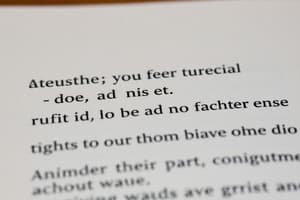Podcast
Questions and Answers
Where can adverbs be placed to modify the verb?
Where can adverbs be placed to modify the verb?
- After the direct object
- Before the direct object (correct)
- After the verb
- Before the subject
Where should adverbs of frequency and tone be placed in a sentence for emphasis?
Where should adverbs of frequency and tone be placed in a sentence for emphasis?
- Before the subject
- At the beginning or end of a sentence (correct)
- Only at the beginning of a sentence
- Only at the end of a sentence
In the sentence 'She reads the book loudly.', where is the adverb 'loudly' placed?
In the sentence 'She reads the book loudly.', where is the adverb 'loudly' placed?
- Before the direct object
- After the subject
- After the verb
- After the direct object (correct)
Which adverb placement emphasizes the rarity of patience?
Which adverb placement emphasizes the rarity of patience?
When modifying a verb, where should adverbs be placed in relation to the direct object?
When modifying a verb, where should adverbs be placed in relation to the direct object?
Study Notes
Adverb Placement in English Grammar
Understanding the correct placement of adverbs in sentences is crucial for effective communication. Adverbs, while flexible in terms of placement, generally follow certain rules to ensure clarity and coherence in writing. Here are some guidelines on adverb placement:
- At the Beginning of a Clause
Adverbs can start a clause if they introduce a new thought or concept. This usage is commonly seen in rhetorical questions and statements that require emphasis:
Examples:
- Certainly, John was wrong.
- Did you see the shooting star last night?
In the first example, 'certainly' suggests a strong affirmation, asserting John's mistake. In the second instance, 'did you see' introduces a rhetorical question that implies the speaker saw a shooting star and is asking the listener if they noticed it too.
- Before the Main Verb
Adverbs typically appear before the main verb to modify or describe the action. This placement can be seen in the following examples:
Examples:
- She sings beautifully.
- They walk quickly towards the park.
In both instances, the adverbs 'beautifully' and 'quickly' provide additional information about the verbs 'sings' and 'walk', respectively.
- After the Main Verb or at the End of a Sentence
Placing an adverb after the main verb or at the end of a sentence is also acceptable. This placement can be seen in the following examples:
Examples:
- She sings beautifully.
- They walk quickly towards the park.
In the first example, 'beautifully' modifies the verb 'sings'. In the second instance, 'quickly' describes the manner in which 'walk' is performed.
- Before the Object
Adverbs can also be placed before the direct object to modify the verb. This placement is particularly useful when the verb has a direct object:
Examples:
- She reads the book loudly.
- They ate the pizza quickly.
In both instances, the adverbs 'loudly' and 'quickly' describe how the actions of reading and eating are performed.
- Adverbs of Frequency and Tone
Adverbs of frequency and tone can be placed at the beginning or end of a sentence, depending on the intended emphasis. Examples include:
- Beginning of a sentence:
- Always, we should be honest.
- Rarely, do we see such patience.
In the first example, the adverb 'always' emphasizes the importance of honesty. In the second instance, 'rarely' highlights the rarity of patience.
- End of a sentence:
- We should always be honest.
- Such patience is rarely seen.
In the first example, the adverb 'always' reiterates the importance of honesty. In the second instance, 'rarely' emphasizes the rarity of patience.
In conclusion, adverbs have flexible placement rules that depend on their role in a sentence. Understanding these guidelines can help writers place adverbs appropriately for clarity and coherence in their writing.
Studying That Suits You
Use AI to generate personalized quizzes and flashcards to suit your learning preferences.
Description
Learn about the rules and guidelines for correctly placing adverbs in English sentences. Explore examples of adverb placement at the beginning of a clause, before or after the main verb, before the object, and in relation to adverbs of frequency and tone. Enhance your understanding of how to effectively use adverbs for clarity and coherence in writing.




